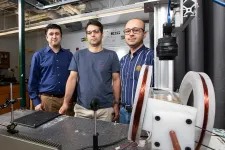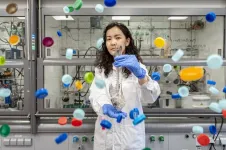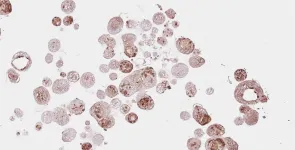(Press-News.org) A new study led by physicist Sascha Kempf at the University of Colorado Boulder has delivered the strongest evidence yet that Saturn’s rings are remarkably young—potentially answering a question that has boggled scientists for well over a century.
The research, to be published May 12 in the journal Science Advances, pegs the age of Saturn’s rings at no more than 400 million years old. That makes the rings much younger than Saturn itself, which is about 4.5 billion years old.
“In a way, we’ve gotten closure on a question that started with James Clerk Maxwell,” said Kempf, associate professor in the Laboratory for Atmospheric and Space Physics (LASP) at CU Boulder.
The researchers arrived at that closure by studying what might seem like an unusual subject: dust.
Kempf explained that tiny grains of rocky material wash through Earth’s solar system on an almost constant basis. In some cases, this flux can leave behind a thin layer of dust on planetary bodies, including on the ice that makes up Saturn’s rings.
In the new study, he and his colleagues set out to put a date on Saturn’s rings by studying how rapidly this layer of dust builds up—a bit like telling how old a house is by running your finger along its surfaces.
“Think about the rings like the carpet in your house,” Kempf said. “If you have a clean carpet laid out, you just have to wait. Dust will settle on your carpet. The same is true for the rings.”
It was an arduous process: From 2004 to 2017, the team used an instrument called the Cosmic Dust Analyzer aboard NASA’s late Cassini spacecraft to analyze specks of dust flying around Saturn. Over those 13 years, the researchers collected just 163 grains that had originated from beyond the planet’s close neighborhood. But it was enough. Based on their calculations, Saturn’s rings have likely been gathering dust for only a few hundred million years.
The planet’s rings, in other words, are new phenomena, arising (and potentially even disappearing) in what amounts to a blink of an eye in cosmic terms.
“We know approximately how old the rings are, but it doesn’t solve any of our other problems,” Kempf said. “We still don’t know how these rings formed in the first place.”
From Galileo to Cassini
Researchers have been captivated by these seemingly-translucent rings for more than 400 years. In 1610, Italian astronomer Galileo Galilei first observed the features through a telescope, although he didn’t know what they were. (Galileo’s original drawings make the rings look a bit like the handles on a water jug). In the 1800s, Maxwell, a scientist from Scotland, concluded that Saturn’s rings couldn’t be solid but were, instead, made up of many individual pieces.
Today, scientists know that Saturn hosts seven rings comprised of countless chunks of ice, most no bigger than a boulder on Earth. Altogether, this ice weighs about half as much as Saturn’s moon Mimas and stretches nearly 175,000 miles from the planet’s surface.
Kempf added that for most of the 20th Century, scientists assumed that the rings likely formed at the same time as Saturn.
But that idea raised a few issues—namely, Saturn’s rings are sparkling clean. Observations suggest that these features are made up of roughly 98% pure water ice by volume, with only a tiny amount of rocky matter.
“It’s almost impossible to end up with something so clean,” Kempf said.
Cassini offered an opportunity to put a definitive age on Saturn’s rings. The spacecraft first arrived at Saturn in 2004 and collected data until it purposefully crashed into the planet's atmosphere in 2017. The Cosmic Dust Analyzer, which was shaped a bit like a bucket, scooped up small particles as they whizzed by.
Engineers and scientists at LASP designed and built a much more sophisticated dust analyzer for NASA’s upcoming Europa Clipper mission, which is scheduled to launch in 2024.
The team estimated that this interplanetary grime would contribute far less than a gram of dust to each square foot of Saturn’s rings every year—a light sprinkle, but enough to add up over time. Previous studies had also suggested that the rings could be young but didn’t include definitive measures of dust accumulation.
Stroke of luck
The rings might already be vanishing. In a previous study, NASA scientists reported that the ice is slowly raining down onto the planet and could disappear entirely in another 100 million years.
That these ephemeral features existed at a time when Galileo and the Cassini spacecraft could observe them seems almost too good to be true, Kempf said—and it begs an explanation for how the rings formed in the first place. Some scientists, for example, have posited that Saturn’s rings may have formed when the planet’s gravity tore apart one of its moons.
“If the rings are short lived and dynamical, why are we seeing them now?” he said. “It’s too much luck.”
Co-authors on the new study include Nicolas Altobelli of the European Space Agency; Jürgen Schmidt of the Freie Universität Berlin; Jeffrey Cuzzi and Paul Estrada of the NASA Ames Research Center; and Ralf Srama of the Universität Stuttgart.
END
New study puts a definitive age on Saturn’s rings—they’re really young
2023-05-12
ELSE PRESS RELEASES FROM THIS DATE:
Researchers identify a brain marker indicating future suicide risk
2023-05-12
FOR IMMEDIATE RELEASE, May 12, 2023
Contact: Gina DiGravio, 617-358-7838, ginad@bu.edu
Researchers Identify a Brain Marker Indicating Future Suicide Risk
Changing the connectivity in this brain circuit with stimulation or pharmacotherapies could represent new treatments to reduce suicide risk.
(Boston)—Identifying people at high risk for suicide is critical for applying lifesaving interventions and treatments. However, it is very difficult to identify who is at greatest risk and only modest improvements has been made in identifying high risk people over the last 50 years. One novel way to identify people at high risk of suicide is by investigating and identifying brain markers.
VA ...
Researchers use 3D models to investigate bacteria movement
2023-05-12
The spiral-shaped bacteria Helicobacter pylori are common and troublesome.
More than 13 percent of Americans have an H. pylori infection, although rates vary with age, race and socioeconomic status. The microorganism uses its corkscrew-like tail to power forward through viscous fluids such as stomach mucus. When it arrives at the epithelium of the stomach wall, it can cause everything from ulcers to cancer.
In a new study published by Physical Review Letters, FAMU-FSU College of Engineering researchers created a 3D model of this bacteria to better understand its movement, hoping to crack the code governing the organism’s motility ...
Researchers at Purdue discover superconductive images are actually 3D and disorder-driven fractals
2023-05-12
Meeting the world’s energy demands is reaching a critical point. Powering the technological age has caused issues globally. It is increasingly important to create superconductors that can operate at ambient pressure and temperature. This would go a long way toward solving the energy crisis.
Advancements with superconductivity hinge on advances in quantum materials. When electrons inside of quantum materials undergo a phase transition, the electrons can form intricate patterns, such as fractals. A fractal is a never-ending pattern. When zooming in on a fractal, the image looks the same. Commonly seen fractals can be a tree or frost on a windowpane ...
Save the phages to protect Big Blue
2023-05-12
The plastic era has begun, and for sure, it will last for decades or even longer. Polymer-based materials are almost everywhere, reaching even the deepest regions of the oceans, and their global production is larger than recycling, leading to the generation of tremendous amounts of water pollution with microplastics. These tiny polymer particles not only release chemicals but also reduce the number of bacteriophages. Recently, researchers from the Institute of Physical Chemistry, Polish Academy of Sciences, led by Prof. Jan Paczesny, explored ...
Head and neck cancer organoids as a step towards personalized treatments
2023-05-12
Researchers from the Organoid group (Hubrecht Institute) and UMC Utrecht have developed a biobank with organoids derived from patients with head and neck cancer (HNC). They used this biobank to validate known HNC biomarkers and found that treatment responses in the organoids matched those seen in patients. The results of the study will be published in Med on 12 May 2023 and could aid treatment decisions and discovery of novel therapies for HCN patients in the future.
Head and neck cancer (HNC) is an overarching term used for several types of cancer, including the most ...
Intestinal bacteria influence the growth of fungi
2023-05-12
The bacteria present in the intestine provide information about the quantities of fungi of the potentially disease-causing Candida genus. Among them, and surprisingly, are lactic acid bacteria that are known for their protective effect against fungal infections. The findings of researchers at the Leibniz Institute for Natural Product Research and Infection Biology (Leibniz-HKI) and their collaborative partners from Denmark and Hungary add another piece to the puzzle of understanding the human gut microbiome.
The ...
Researchers discover novel "Shanghai APP" mutation in late-onset Alzheimer's disease, offering new avenues for treatment
2023-05-12
Alzheimer's disease (AD) is a progressive neurodegenerative disorder affecting tens of millions of people worldwide, and it is the most common cause of dementia. Early-onset AD is typically associated with mutations in the genes APP, PSEN1, and PSEN2, leading to a more aggressive form of the disease with atypical symptoms. In contrast, the newly discovered "Shanghai APP" mutation has been linked to LOAD, which affects a larger population of AD patients.
In a study published in Genes & ...
Breakthrough technology: Carbon nanotube membranes with Pd-Cu modification successfully reduce nitrate levels via electrocatalysis
2023-05-12
The adverse effects of excess nitrate in water on human productivity and lives have received increasing attention due to the discharge of industrial wastewater and the overuse of farmland fertilizers. An international team of researchers has conducted an in-depth study of the significant need and challenge of efficient nitrate removal.
Several techniques have been used to eliminate nitrate from water, such as biological denitrification is technologically mature, cost-effective, and widely used. However, biological processes are often sluggish and ...
Samsung Electronics – DGIST, establishment of ”Semiconductor Contracting Department” for fostering semiconductor development talent
2023-05-12
□ DGIST (President Yang Kook) (the following three science and technology institutions) will establish a "Semiconductor Contracting Department" with Samsung Electronics for fostering technical staff specialized in semiconductor manufacturing processes.
□ DGIST closed a business agreement on the 27th (Mon) at DGIST University Center Convention Hall for establishing and operating the Semiconductor Contracting Department, which was attended by Samsung Electronics President Seokwoo Nam and Wanpyo Kim, DGIST President Yang Kook, and other major stakeholders.
□ Owing to the recently increasing global semiconductor demand, safeguarding national competitiveness ...
The DGIST increases clinical diagnosis accuracy through the development of rare cell loss minimization technology.
2023-05-12
□ DGIST (President Yang Kook) Professor Minseok Kim of the Department of Neurobiology and his team developed lossless immunocytochemistry technology, which facilitates analysis of rare cells that present in trace amounts in clinical specimens. The corresponding technology developed together with CTCELLS, Inc. involves the use of an ultra-thin film hydrogel to facilitate fluid exchange while inhibiting cell loss, and a higher preservation rate and reproducibility were achieved compared to existing cell ...




